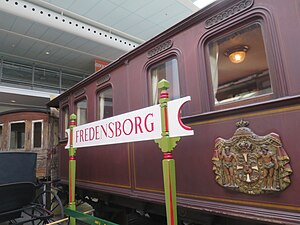SJS Ra
| SJS Ra / DSB SA 1 / DSB S 1 | |
|---|---|
|
Salon car in the Odense Museum
|
|
| Number: | 1 |
| Manufacturer: | Lauensteinsche Wagenbau-Gesellschaft, Hamburg |
| Year of construction (s): | 1871 |
| Retirement: | 1900 (1934) |
| Gauge : | 1435 mm ( standard gauge ) |
| Length over buffers: | 12.73 m |
| Empty mass: | 17.8 t |
| Train heating: | Tiled stove and radiator based on the Lilliehöök system |
| Seats: | 2 salon compartments, 3 side rooms |
| Vacuum line | |
The Danish SJS Ra saloon car was built by the Zealand Railway Company Det Sjællandske Jernbaneselskab for King Christian IX. and Queen Louise built. It is now in the Danish Railway Museum in Odense .
history
The saloon car was commissioned by the Zeeland railway company Det Sjællandske Jernbaneselskab in 1870 and built by the Lauenstein'schen Wagen-Fabrik-Gesellschaft in Hamburg at a price of 8,865 "Prussian Thalers" (= 26,595 marks ).
The individual parts of the car arrived in Århus on December 19, 1870, packed in 105 boxes . In March 1871 the boxes were brought to Korsør by sailing ship, after which the wagon was assembled there. On April 14, 1871 the car was ready and was given the road number SJS Ra by Det Sjællandske Jernbaneselskab .
It replaced an older vehicle from the early days of the railroad in Denmark, which was obsolete due to technical progress.
DSB SA 1 (I)
In 1880 Det Sjællandske Jernbaneselskab was taken over into state ownership. This and Jysk-Fyenske Jernbaner remained independent under state control with their own organizations until they were merged in 1885 to Danske Statsbaner (DSB). The official renaming of the car to DSB SA 1 did not take place until 1893.
DSB S (I) 1
In 1900 the vehicle, overtaken by technical progress, was replaced by a more modern one. However, it remained in the fleet as a royal saloon car. In 1903 the company number was changed to DSB S 1 . Until 1933 it was located in the saloon car hall in Hellerup. In 1934 the car was taken out of service and transferred to the inventory of the Railway Museum. The car was in Østerport until 1966. It has been exhibited there since moving into the round shed of the former railway depot in Odense .
vehicle
The platform trolley has an open entry platform at each end . It is 17.8 m long and runs on three axes, each 3.43 m apart. The 2.59 m wide interior has the typical design of the saloon car of the time: the entry platform is followed by a narrow entrance area with two opposite seats for the servants (one window axis). This is followed by the salon with four window axes that extend over the entire width of the car, as well as a “relaxation area” with two sofas that can be used as loungers, which also extend over the entire width of the car (two window axes). In front of the end of the central aisle, which ends with a door to the second entry platform, the toilet and a washroom are located on the left and right.
commitment
The vehicle was often on the move between Copenhagen Central Station and Fredensborg when the Danish royal family resided at Fredensborg Palace in the summer and received relatives from all over Europe there. The members of the royal family used one of the car's disks to carve their first names or nicknames with the diamonds on their rings during such journeys . This disk was removed from the car and is now kept at Rosenborg Castle in Copenhagen .
literature
- Labeling on the object in the Danish Railway Museum in Odense [2019].
- Poul Thestrup: Danske Kongevogne . Bane Boger, Roskilde 1992. ISBN 87 88632 39-3
Web links
- Information about the car on the website of the Danish Railway Museum, Odense; accessed on July 24, 2019
Remarks
- ↑ Source: Thestrup: Danske Kongevogne , p. 27, they were actually club thalers back then .
-
↑ With doodles there are u. a. (Thestrup: Danske Kongevogne , p. 31):
- "Bertie", King Edward VII , son-in-law of King Christian IX.
- "Sascha", Tsar Alexander III. , Son-in-law of King Christian IX.
- "Dagmar", Tsarina Maria Feodorovna of Russia, daughter of King Christian IX.
- "Apapa", King Christian IX.
- "Amama", Queen Louise, (wife of Christian IX.)
- "Fredy", King Frederik VIII.
- "Louise", Queen Louise of Denmark (wife of Frederik VIII)
- "Georg", King George V of England or Prince George of Greece
- "Christian", King Christian X.
Individual evidence
- ↑ Steam heater for Swedish State Railways passenger cars based on the Lilliehöök system. Retrieved July 26, 2019 .
- ↑ Thestrup: Danske Kongevogne , p.27
- ↑ SJS Ra. In: jernbanen.dk. Retrieved July 26, 2019 (Danish).
- ↑ Thestrup: Danske Kongevogne , p.23
- ↑ DSB SA 1. In: jernbanen.dk. Retrieved July 26, 2019 (Danish).
- ↑ a b Labeling on the object
- ↑ DSB S 1. In: jernbanen.dk. Retrieved July 26, 2019 (Danish).
- ↑ Thestrup: Danske Kongevogne , p.28

